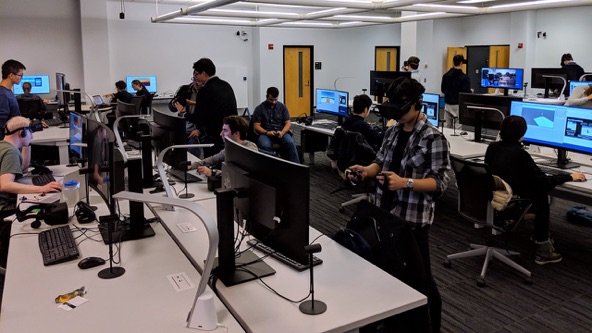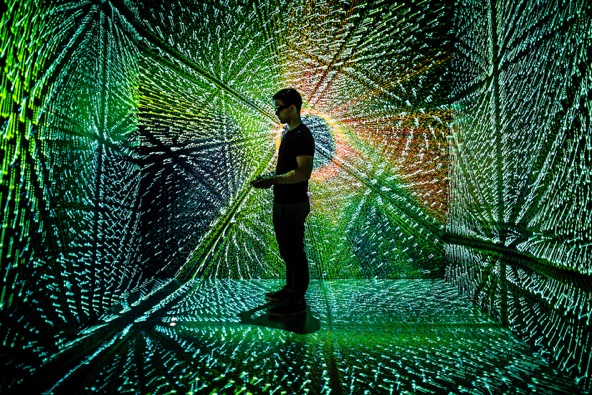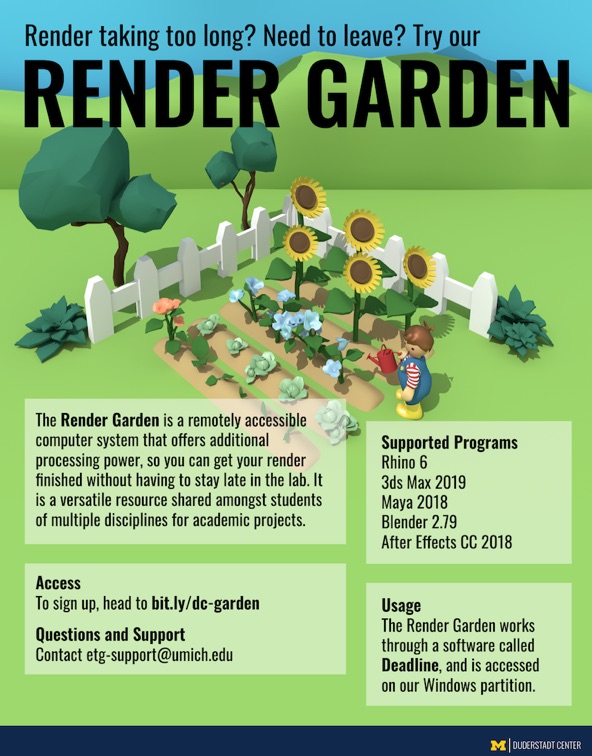RX VISUALIZATION SPACES

The Emerging Technologies Group
The Emerging Technologies Group at the Duderstadt Center focusses on cutting edge visualization technologies to assist faculty throughout the entire university with the development of grant funded, visualization-based projects.
ETG provides consultation and development toward projects around the use of Augmented/Virtual/Mixed Reality technologies. Consultation is free-Even if you have nothing more than an idea in your head, the best way to see if you’re on the right path or have fully considered what development means for your project is to schedule a consultation with our group. Our team of experts can help walk you through the key questions, demonstrate various technologies, help identify opportunities for fund raising and content creation, and bring in other resources from across campus to ensure the right people are at the table as we figure out a solution. We have expertise in developing projects for a wide variety of platforms and use-cases, and have developed close partnerships with many of the schools across campus.
We can work with you on:
-
•Data Visualization: Visualization of data that has been modified/filtered to help with understanding. (e.g. extracting gender/age from census report)
-
•Scientific Visualization: Visualization of unfiltered/unmodified data directly from it’s source, occasionally in real-time. (e.g. digitially slicing through MRI scans)
-
•Illustrative Visualization: Visualizing a concept or theory that is not represented entirely by it’s data. (e.g. animation depicting concepts around dark matter)

The Visualization Studio provides campus-wide access to augmented/virtual reality development workstations and equipment. Each station is equipped with an Oculus Rift S or HTC Vive Pro Wireless VR headset. Microsoft Hololens, LEAP motion, Intuos drawing tablets, 360 cameras etc are also available to the students through the Duderstadt Center checkout system.
Visualization Studio workstations are all outfitted with the latest development software including a plethora of 3d modeling packages, game engines like Unity or Unreal Engine, 3ds Max Interactive, Enscape and our own in-house VR rendering software, Jugular. The space is designed to give students, staff and faculty access to cutting edge equipment and expert staff that are able to orient them to these new technologies and pipelines.
The Duderstadt Center has a long history of providing tailored AR/VR development for grant-based research and learning tools on campus, and is available fo consultation on AR/VR based grants. The Visualization Studio aims to make these development pipelines more known and accessible.
While we can occassionally accomodate reservations for workshops or special events, access to the studio is intended to be open to all on a walk-in basis.

The Duderstadt Center offers the only cave-like VR experience on campus with its Virtual Reality "M.I.D.E.N" (Michigan Immersive Digital Experience Nexus).
The M.I.D.E.N relies on stereoscopic projections for its effect but the system takes the concept much further. The M.I.D.E.N. tracks where the user is within a space and adapts to the simulation to what the person would expect to see. It is a 10 x 10 x 10 foot (3.048 x 3.048 x 3.048 meter) immersive audio-visual environment that offers 3D stereoscopic projection on the left, front, right, and floor surfaces. Users can walk naturally within the physical boundaries of the space, use a game controller to navigate through a larger virtual space, and see their own bodies in the context of the projected virtual environment. The M.I.D.E.N. brings together a wide variety of disparate technologies to create the highest level of immersion that effectively places you “inside” the data.
Our team of graphics programmers maintain the Jugular software used to drive the M.I.D.E.N, making it capable of accepting a wide range of data not typically compatible with a VR cave and also allowing scenes generated for the M.I.D.E.N to be viewed with a portable, head mounted, VR display like the Oculus Rift. If you are interested in utilizing the M.I.D.E.N or the Jugular software to load your content we request you export your data as *.VRML, *.FBX or *.OBJ formats.
Access to the M.I.D.E.N for use in student project work or teaching exercises is available by request.
Motion and Static 3D Capturing
Capturing technologies allow an existing physical object or motion to be re-created in digital form.
This is a process often used in the preservation of artifacts and in iterative design. The ability to take an existing object and re-create it digitally allows artifacts to be forever preserved and also made more widely available through digital platforms. For inventors, designers and creators, capturing an existing object can allow for improvements to its design and functionality in digital form.
Motion Capture
The Vicon Motion Capture technology available through the Visualization Studio is the same system used by major Hollywood productions like Avatar or Planet of the Apes to translate realistic motion onto digital characters. We offer a 9-camera system suitable for capturing the movement of people, robotics, and other objects. This technology is available through reservation, and involves scheduling a capturing session with the Duderstadt Center's Motion Capture expert. After a session is complete, the resulting motion data is available in *.FBX, *.BVH or *.TRC formats.
If you are interested in a low-cost, introductory motion capture option, the Visualization Studio workstations all offer support for Leap Motion as well as a Perception Neuron system (this is a Mocap suit that utilizes accelerometers and gyroscopes - available by request).
To schedule a Vicon motion capture session, we will need a description of what you are looking to capture & the number of subjects involved. After a capture session, you will be responsible for cleaning the resulting data within the Shogun software (instruction will be provided). Contact us to request a session or inquire about other motion capturing methods that are available.
Photogrammetry
Photogrammetry is a process that can be done within your own home if you have access to a digital camera. Objects with a lot of surface detail work great with this method, as the algorithm that generates a model analyzes your photos on a per-pixel basis, looking for features it can identify across 2 or 3 photographs. If it can locate the same feature across several photographs, that feature can be triangulated in 3D space, allowing a model to be constructed from a plotted point-cloud.
The Visualization Studio houses a Photogrammetry room dedicated to simplifying and expediting the process of scanning with this method. This can be particularly helpful for large-scale objects or subjects like people (that move slightly and need to be photographed quickly). Photogrammetry has the ability to preserve very high resolution color information on the surface of an object as the photos used in generating a model are mapped to the model’s surface. Depending on the subject, the precision of the resulting model can sometimes rival that of a laser scanner.
The Photogrammetry room inside the Visualization Studio offers several software packages for processing Photogrammetry, including Agisoft Photoscan, Autodesk Recap Photo, Reality Capture and 3DF Zephyr. Models and point cloud data generated through Photogrammetry can be exported as *.OBJ, *.PLY, *.STL, *.FBX, Adobe PDF, *.3DS, COLLADA,*.DXF & *.U3D format. These formats are suitable for purposes like 3D printing, creating 3d collections on the web, or bringing content into a game engine for porting to an AR or VR device.
Visualization Hubs (VizHubs)
VizHubs 1 & 2
The Duderstadt Center has two Visualization Hubs (VizHubs) on the second floor of the building. These workstations can be reserved online at or on the iPad reservation systems (only available for immediate reservations) located at the VizHub themselves.
The vizhub workstations are large collaborative workstations with an 84’’ UHD Video Display and 10Gbit ethernet connectivity. This enables extremely fast transfer of datasets to the machine and real time visualization of extremely large datasets.
There are high speed USB 3.0 ports on the desk for fast data transfer, as well as power outlets for charging all of your devices. These workstations support display from personal laptops, or the built in CAEN computers,
VizHubs 3 - 13
In addition to the two large VizHubs, the second floor also contains 11 smaller collaborative workstations with dedicated 55’’ 1080p flat screen video displays and CAEN computers. These spaces contain enough chairs to seat five people and are sectioned off for a modicum of privacy. For those who want to connect their personal devices to the video display, VGA and HDMI cables are readily available for use, simply plug and play.
Render Farm

The Duderstadt Center has an in-house render farm intended to expedite your rendering efforts, be they large format renders intended for print, or frame-by-frame renders for animation.
Our render farm is accessible to you once an account has been created, through the Deadline client software available in Groundworks and the Visualization Studio. The Render Farm is compatible with the following software/renderers:
-
•Rhino
-
•3d Studio Max
-
•Maya
-
•Blender
-
•Arnold
-
•V-Ray
To get access to this resource, please fill out the form. You will be provided instructions for setting up your files for rendering through the Deadline client and allocated a folder on our server space that the render farm can write to. Once your files are submitted, you can log out and return at a later time to retrieve your completed render.